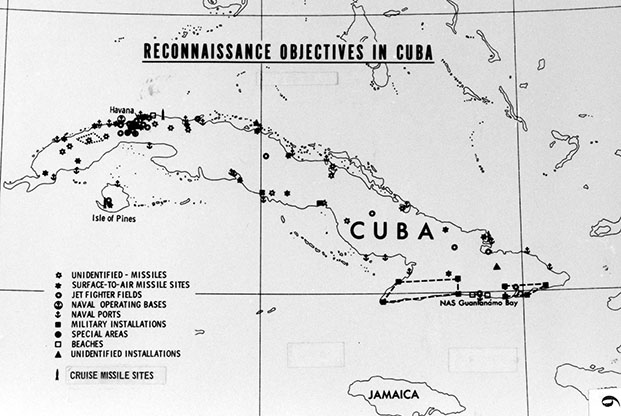
Operation Mongoose was the American military’s plan to invade and occupy Cuba as tensions rose in the early 1960s, largely due to the threat of nuclear power in the country. Newly released documents reveal details about the plan. This CIA map show the range of the nuclear missiles placed in Cuba. Photo: The John F. Kennedy Presidential Libray and Museum
The Air Force was front and center in the 1962 American plan to take control of Cuba, newly released documents show.
Seizing control of “key strategic areas in Cuba” would require 261,000 military personnel, according to the now released outline of requirements for such a move. That figure is based on achieving the mission “within 10-15 days with minimum casualties to both sides.” Having a plan in place for such an invasion was “mandatory” according to a document briefing Robert Kennedy—who oversaw Cuba matters—about a potential invasion of the country. The briefing warned Soviet forces could “establish military bases in Cuba at their will and pleasure and if they exercise this option, we would likely be unable to remove without initiating World War III.”
The National Archives released the document Thursday as part of a 2,891-record dump, abiding by a 1992 ruling subjecting records related to the assassination of President John F. Kennedy.
According to the outline, Air Force Brig. Gen. Edward Lansdale, who was in charge of the invasion plans—or Operation Mongoose—requested a breakdown of a potential invasion for “consequences” of American intervention in Cuba. This included effects on “world-wide ability to react” and what it would take to sustain occupation, from national mobilization to equipment.
The resulting Aug. 8, 1962, memo calls for 17 USAF tactical fighter squadrons and 53 troop carrier or transport squadrons. Equipment from the Air Force comprised “about 490” troop carriers and transports, 312 tactical fighters, and 65 reconnaissance and refueling aircraft. As for mobilization, the memo shows an original plan would’ve had 14 Reserve “troop carrier squadrons (C-119),” that parentheses likely referring to the Flying Boxcar. But the Air Force was asked to “prepare alternate plans not involving any mobilization prior to D-day.”
Other personnel requested:
- 71,000 Army and 35,000 Marine forces for ground engagement
- 29,000 Army troops on call
- Two Army airborne divisions
- One infantry brigade
- One armored combat command
- “One and one-third” Marine division/wing teams
- One Navy striking and covering force with an amphibious task force
Other equipment requested:
- Army: Artillery and armor, including 275 Army tanks
- Marines: Artillery and armor, including 85 Army tanks, “plus some 320 supporting aircraft”
- Navy: Approximately 175-200 ships, including two aircraft carriers with approximately 180 aircraft
In an earlier memo from March 1962, the CIA requested assistance in Cuba, specifically asking for three Air force “cargo aircraft with ‘sheep-dipped’ USAF crews for air re-supply, two amphibious aircraft with ‘sheep-dipped’ USAF crews,” along with Navy personnel and equipment. Lansdale followed that memo two days later with one of his own on March 14, 1962, emphasizing the need for CIA’s ask.

During the 1962 Cuban Missile Crisis, the Air Force used the above map, which shows the locations of valuable reconnaissance targets. USAF photo.
Two months following the circulation of the invasion breakdown outline, reconnaissance aircraft reported back sightings of Russian ICBMs activity in the region, triggering the Cuban Missile Crisis, which Air Force Magazine reviewed in 2012.
Former editor John T. Correll overviewed Operation Mongoose in the article:
In November 1961, the President authorized Operation Mongoose to foment an uprising in Cuba and overthrow Castro. The project was overseen by Bobby Kennedy with the flamboyant Edward G. Lansdale, the Administration’s favorite insurgency specialist, as operations chief.
Mongoose endorsed sabotage, psychological warfare, propaganda, infiltration by guerillas, disinformation, and much more. Not revealed until much later were half-baked schemes to assassinate Castro with exploding cigars or to use depilatories to make his hair and beard fall out. Cuban-Soviet fears of an invasion were not totally unfounded. In early 1962, as part of Mongoose, the US military developed contingency operation plans for the invasion and occupation of Cuba.
A wargame in August 1962 featured a mock assault on the Puerto Rican island of Vieques and the simulated overthrow of a leader named “Ortsac,” or Castro spelled backward.